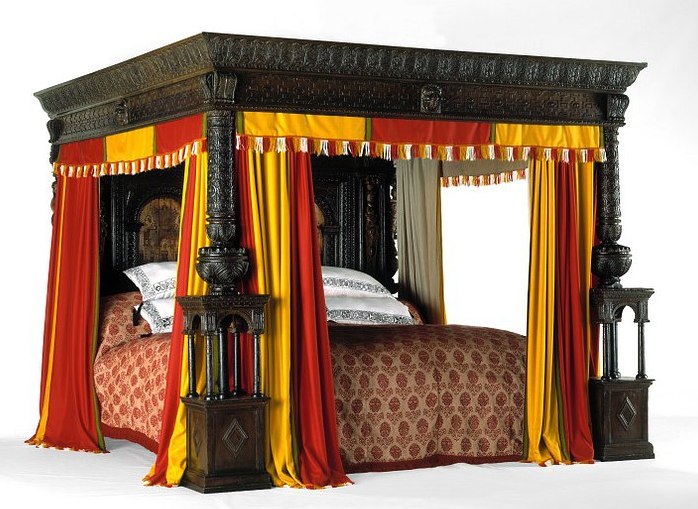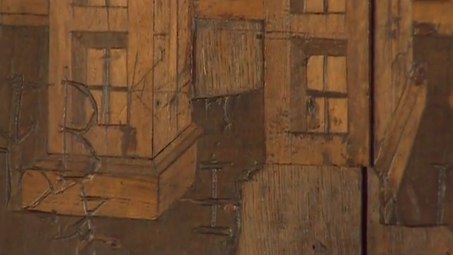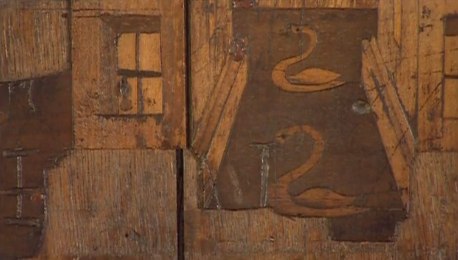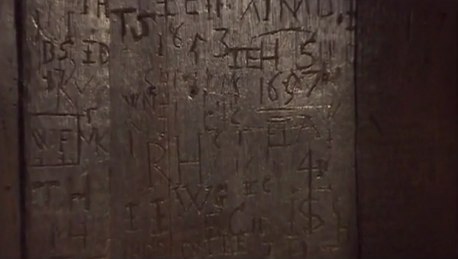By Beth Dunn
Lovers have been carving their initials into tree trunks and fenceposts since time immemorial. It seems like if you’re in love, you’re a fool if you don’t carry a pocket knife at all times, just so that you can proclaim your passion to the world.
Maybe this is why the biggest bed in Christendom is simply riddled with graffiti.
I mean, maybe folks just like carving their names in stuff. But I bet there’s more to it than that.
The Great Bed of Ware has been a tourist attraction for a very long time, and it’s hard to say if most of its carved initials are the result of over-excited tourists marking their passage along the great road north out of London, or if some are actually the remnants of a night of passion in a provincial inn in Hertfordshire. Built in the late 16th century and known to have graced the rooms of several different public inns in the English town of Ware, this staggeringly large and delightfully ornate bed has been sought out by the curious and the coital for hundreds of years.
The bed can now be found in the British Galleries of the wonderful Victoria and Albert Museum in London, where you can get right up close and marvel at its immense girth and vasty depths. It really is massive, even by today’s standards. And you can see why it ranked among the top must-see sights in the itineraries of generations of British travelers.
As an item of antiquity, it’s appeared in some pretty impressive footnotes. Shakespeare mentioned it in Twelfth Night. Byron mentioned it in Don Juan.
As a piece of furniture, it practically ranks as sculpture rather than utilitarian object. It’s almost 12 feet square, anchored by two massive carved posts at the foot, and balanced by an equally overwrought headboard. But people can — and did — sleep in it. Sometimes it was booked to accomodate as many as twelve people at once, although frankly this seems to have been more in the way of a prank or a dare than anything else. Sort of the Elizabethan equivalent of seeing how many coeds you can stuff into a phone booth, if you get my drift.
But that graffiti? It’s everywhere.
On the finely carved figures.
Among the carefully wrought marquetry.
Alongside the swans, for which the town of Ware was evidently renowned.
All crammed together, like coeds in a phone booth.
And while graffiti of this sort can be seen on museum pieces of all kinds, from medieval choir pews to ancient Roman frescoes, I’d like to think that at least some of the graffiti on the Great Bed of Ware served a more intimate purpose.
Surely at least some of these initials were carved in a moment of celebration, of giddy excitement or satisfied bliss. Surely some of these marks are the silent relics of two actual, living people, who spent an actual, living night with each other in a bed bigger than any bed they’d ever seen before. A bed that seemed tailor-made for lovers whose love was vast, and for whom the years ahead seemed endless and filled with promise.
A bed whose creaking frame still spells out their names, if you know where to look.
In code, yes. And nearly drowned out by all the sly chuckles and crude jokes of the tourists who all but crowd our lovers’ names out of view.
But they’re still there, just the same. Because some things truly never change.





